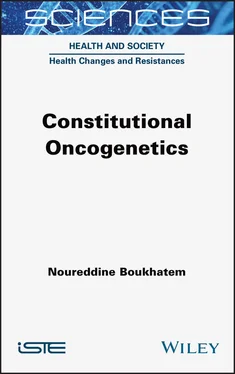1 Cover
2 Title Page SCIENCES Health and Society , Field Director – Bruno Salgues Health Changes and Resistances , Subject Head – Bruno Salgues
3 Copyright First published 2021 in Great Britain and the United States by ISTE Ltd and John Wiley & Sons, Inc. Apart from any fair dealing for the purposes of research or private study, or criticism or review, as permitted under the Copyright, Designs and Patents Act 1988, this publication may only be reproduced, stored or transmitted, in any form or by any means, with the prior permission in writing of the publishers, or in the case of reprographic reproduction in accordance with the terms and licenses issued by the CLA. Enquiries concerning reproduction outside these terms should be sent to the publishers at the undermentioned address: ISTE Ltd 27-37 St George’s Road London SW19 4EU UK www.iste.co.uk John Wiley & Sons, Inc. 111 River Street Hoboken, NJ 07030 USA www.wiley.com © ISTE Ltd 2021 The rights of Noureddine Boukhatem to be identified as the author of this work have been asserted by him in accordance with the Copyright, Designs and Patents Act 1988. Library of Congress Control Number: 2020946632 British Library Cataloguing-in-Publication Data A CIP record for this book is available from the British Library ISBN 978-1-78945-016-3 ERC code: LS2 Genetics, ‘Omics’, Bioinformatics and Systems Biology LS2_5 Epigenetics and gene regulation LS7 Applied Medical Technologies, Diagnostics, Therapies and Public Health LS7_2 Genetic tools for medical diagnosis
4 Foreword Foreword I know Professor Noureddine Boukhatem from Mohamed I University in Morocco well, and I have been able to appreciate during his visits, since 2017, to my oncogenetics department at the Centre Jean-Perrin in Clermont-Ferrand his human qualities, his commitment and his enthusiasm for oncogenetics. A “Tour de France” of major oncogenetic consultations has enabled him to have an informed and multidisciplinary view of modern oncogenetics. Oncogenetics is defined as the management of families presenting a suspected hereditary risk of cancer, which is considered to be the cancer risk factor with by far the highest predictive value. The discovery of the first hereditary cancer risk genes in the late 1980s (TP53 and RB1 genes) provided doctors with a diagnostic tool that was essential to the practice of oncogenetics. The high predictive value of these genetic tests enables the physician to implement screening measures for individuals and families at high risk of cancer in order to improve the prognosis when cancer occurs, but also to implement preventive measures for high-risk cancers whenever possible in order to reduce their incidence. Oncogenetics came into existence about 30 years ago in a few countries, including France, which in 1991 created the Génétique et Cancer (Genetics and Cancer) group, which structured the national organization of oncogenetics through the implementation of the first consultations in Clermont-Ferrand, then in Lyon and then in Paris. It was not until 2002–2003 that the first cancer plan led to the creation of the Institut national du cancer (French National Cancer Institute), which then officially supported oncogenetic activities, first in the molecular diagnosis laboratory, then in consultation and then in the monitoring of people at high risk of cancer. From this support, a territorial network was set up to provide effective care for families at high risk of cancer. France has thus become a model of organization at the national level of oncogenetics. Oncogenetics has developed mainly in Europe and North America. Unfortunately, this discipline remains elementary or reserved for a fortuitous and educated elite in many countries, particularly in Asia and Africa. This is why Professor Noureddine Boukhatem’s approach to writing a book on oncogenetics is valuable and useful for the medical community. He has produced an encyclopedic work with a concise presentation and an extensive bibliography, highly useful as a reference. This work is thus strongly recommended for oncogenetic doctors or students who are going to practice medical genetics. Yves-Jean BIGNON Director of the oncogenetics department Centre Jean-Perrin in Clermont-Ferrand October 2020
5 Introduction
6 PART 1: Major Syndromes 1 Hereditary Breast and Ovarian Cancer Syndrome Including Isolated Ovarian Cancers 1.1. Introduction 1.2. Prevalence 1.3. Indications for genetic testing 1.4. Tumors 1.5. Genes 1.6. Genotype–phenotype correlations 1.7. Penetrance 1.8. Mode of transmission 1.9. Risks to family members: special consideration 1.10. Monitoring 2 Lynch Syndrome2.1. Introduction 2.2. Prevalence 2.3. Genes 2.4. Genotype–phenotype correlations 2.5. Penetrance and survival 2.6. Long-term prevalence of cancer in LS patients 2.7. Mode of transmission 2.8. When to suspect LS 2.9. Tumors 2.10. Monitoring 3 Neurofibromatosis3.1. Introduction 3.2. Neurofibromatosis type 1 3.3. Neurofibromatosis type 2 3.4. Schwannomatosis 4 Familial Adenomatous Polyposis4.1. Introduction 4.2. Prevalence 4.3. When to suspect FAP 4.4. Tumors 4.5. Genes 4.6. Genotype–phenotype correlations 4.7. Penetrance 4.8. Mode of transmission 4.9. Monitoring 5 Endocrine Neoplasia5.1. Introduction 5.2. Prevalence 5.3. When to suspect endocrine neoplasia 5.4. Tumors 5.5. Genes 5.6. Genotype–phenotype correlations 5.7. Penetrance 5.8. Mode of transmission 5.9. Monitoring 6 Hereditary Paraganglioma– pheochromocytoma6.1. Introduction 6.2. Prevalence 6.3. When to suspect a PCC/PGL 6.4. Tumors 6.5. Genes 6.6. Genotype–phenotype correlations 6.7. Penetrance 6.8. Mode of transmission 6.9. Monitoring 7 Birt–Hogg–Dubé Syndrome7.1. Introduction 7.2. Prevalence 7.3. When to suspect BHD syndrome 7.4. Tumors 7.5. Gene 7.6. Genotype–phenotype correlations 7.7. Penetrance 7.8. Mode of transmission 7.9. Monitoring 8 RASopathies8.1. Introduction 8.2. Prevalence 8.3. When to suspect RASopathies 8.4. Tumors 8.5. Genes 8.6. Genotype–phenotype correlations 8.7. Penetrance 8.8. Mode of transmission 8.9. Monitoring 9 Familial Malignant Melanoma9.1. Introduction 9.2. Prevalence 9.3. When to suspect familial malignant melanoma 9.4. Tumors 9.5. Genes 9.6. Genotype–phenotype correlations 9.7. Penetrance 9.8. Mode of transmission 9.9. Monitoring 10 Gorlin Syndrome10.1. Introduction 10.2. Prevalence 10.3. When to suspect GS 10.4. Tumors 10.5. Genes 10.6. Genotype–phenotype correlations 10.7. Penetrance 10.8. Mode of transmission 10.9. Monitoring
7 PART 2: Infracentesimal Syndromes 11 Li—Fraumeni Syndrome11.1. Introduction 11.2. Gene 11.3. Tumors 11.4. Genetics 11.5. Monitoring 12 Ataxia–telangiectasia12.1. Introduction 12.2. Gene 12.3. Tumors 12.4 Genetics 12.5. Monitoring 13 Hyperparathyroidism13.1. Introduction 13.2. Gene 13.3. Tumors 13.4. Genetics 13.5. Monitoring 14 Hamartomatous Polyposis Syndromes 14.1. PTEN-hamartoma tumor syndromes 14.2. Juvenile polyposis syndrome 14.3. Peutz–Jeghers syndrome 15 Fanconi Syndrome15.1. Introduction 15.2. Gene 15.3. Tumors 15.4. Genetics 15.5. Monitoring 16 Hereditary Diffuse Gastric Cancer16.1. Introduction 16.2. Gene 16.3. Tumors 16.4. Genetics 16.5. Monitoring 17 Von Hippel–Lindau Disease17.1. Introduction 17.2. Gene 17.3. Tumors 17.4. Genetics 17.5. Monitoring 18 Xeroderma Pigmentosum18.1. Introduction 18.2. Gene 18.3. Tumors 18.4. Genetics 18.5. Monitoring 19 Hereditary Papillary Renal Carcinoma19.1. Introduction 19.2. Gene 19.3. Tumors 19.4. Genetics 19.5. Monitoring 20 Retinoblastoma20.1. Introduction 20.2. Gene 20.3. Tumors 20.4. Genetics 20.5. Monitoring 21 Carney Complex21.1. Introduction 21.2. Gene 21.3. Tumors 21.4. Genetics 21.5. Monitoring 22 Hematological Malignancies22.1. Introduction 22.2. Gene 22.3. Tumors 22.4. Genetics 22.5. Monitoring 23 Familial Pituitary Adenomas23.1. Introduction 23.2. Gene 23.3. Tumors 23.4. Genetics 23.5. Monitoring 24 Bloom Syndrome24.1. Introduction 24.2. Gene 24.3. Tumors 24.4. Genetics 24.5. Monitoring 25 Werner Syndrome25.1. Introduction 25.2. Gene 25.3. Tumors 25.4. Genetics 25.5. Monitoring
Читать дальше












